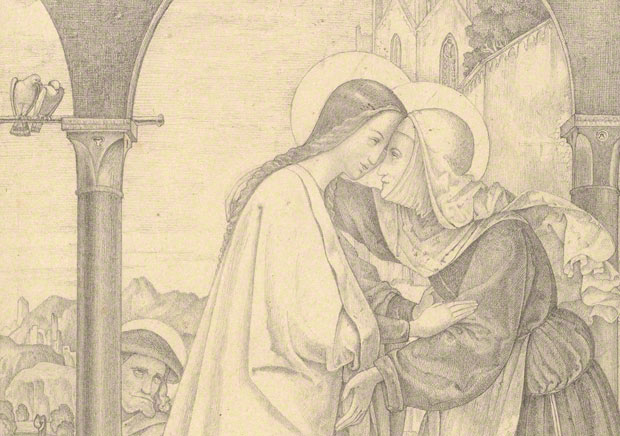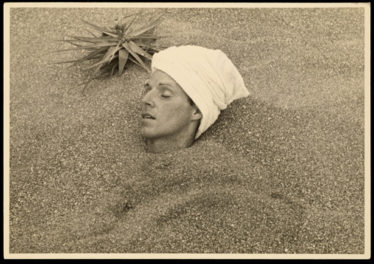
In the emerald-green galleries of the exhibition Spirit of an Age: Drawings from the Germanic World, I was drawn to a cluster of quiet drawings that convey beautiful stories: miraculous healings, heroic quests of medieval knights, momentous coronations. These are the works of the Nazarenes, a group of devout Germanic artists who lived in Rome in the early 19th century, brandishing graphite and ink to pay tribute to God and nature.
“They were about telling religious stories, not about expressing ego or making statements about art for art’s sake,” Edouard Kopp, assistant curator of drawings and the curator of the exhibition, told me. “They were very much literary artists.’’

The Coronation of Charlemagne, Julius Schnorr von Carolsfeld, 1840. Brown ink over graphite on paper. The J. Paul Getty Museum, 2009.5
The stories told by the Nazarenes are just one part of Spirit of an Age, which showcases 42 works in ink, chalk, graphite, and gouache by a variety of German and Austrian artists, including key figures such as Josef Anton Koch, Adolf von Menzel, and Gustav Klimt. The exhibition’s title comes from German philosopher Georg Wilhelm Hegel, who professed that art essentially reflects the spirit of the age—or “Zeitgeist”—in which it was made.
Between 1770 and 1900, the years covered by the show, the Germanic world went through tremendous upheaval. There was, notably, the chaos caused by the Napoleonic invasions. Intellectual heavyweights, like Johann Wolfgang von Goethe, triggered earthquakes in conventional thought. The century also saw the birth of modern Germany as well as the Industrial Revolution, the economic transformation that brought us railroads and steam-powered ships. A psychological freight train—Sigmund Freud’s development of psychoanalysis—was right around the corner.
In the midst of this whirlwind, the Nazarenes fixed their mind on the divine. They lived in Rome, leading a quasi-monastic life. Some fellow German artists and writers criticized the Nazarenes for paying homage to Italian Renaissance artists like Raphael. Goethe, a most influential writer on art, was one of those who scoffed. He thought that the Nazarenes were going backwards, instead of shaping an art in keeping with modern life.
But the Nazarenes’ work has a quiet power and authenticity that’s as uplifting, in a sense, as a Viennese waltz or a thundering Wagner opera. Julius Schnorr von Carolsfeld, for example, shows grace and power in this pen-and-ink drawing, Elijah Revives the Son of the Widow of Zarephath. In an intimate scene, the prophet Elijah beckons God to heal a widow’s child as she weeps—and as the child, arms outstretched, comes back to life.

Elijah Revives the Son of the Widow of Zarephath, Julius Schnorr von Carolsfeld, 1842. Black ink on paper. The J. Paul Getty Museum, 2009.13
(Another miraculous feat: this drawing was a study for one of 240 intricate illustrations in the monumental Bible in Pictures (Bibel in Bildern), which took Carolsfeld 40 years to finish.)
Like his fellow Nazarenes, Carolsfeld emphasized clear, unbroken lines. His drawings typically eschew the use of color. It seems that nothing ought to distract the viewer’s attention from what the critic Friedrich Schlegel called the “divine light of inner spirituality.”
Theodor Rehbenitz’s The Visitation is a fine example of how to render a divine glow without color. The Virgin Mary and her cousin Elizabeth, their faces in full halo, sweetly embrace as they privately rejoice at their mutual pregnancies. The faces are reminiscent of the paintings of Fra Angelico, while the draperies evoke the prints of German Renaissance master Albrecht Dürer.

The Visitation (detail), Theodor Rehbenitz, 1820. Graphite on paper. The J. Paul Getty Museum, 2009.70
In a far more public scene, Carolsfeld’s The Coronation of Charlemagne celebrates the crowning of the first leader of the Holy Roman Empire, as an enthusiastic crowd gestures with excitement. Commissioned by Ludwig I, King of Bavaria, the drawing was a study for a fresco for his Munich palace to honor the ties between Italy and Catholic Germany.
If you’re craving color, though, wander around the rest of Spirit of an Age and you’ll see works by artists who pursued other aesthetic goals—from extolling the hard-working peasant to synthesizing art and music. The drawings offer up contrasts as dramatic as the age itself: a picture-perfect pastel spring, a stroll along the Dresden riverbank, even a place to rest your head.





Comments on this post are now closed.